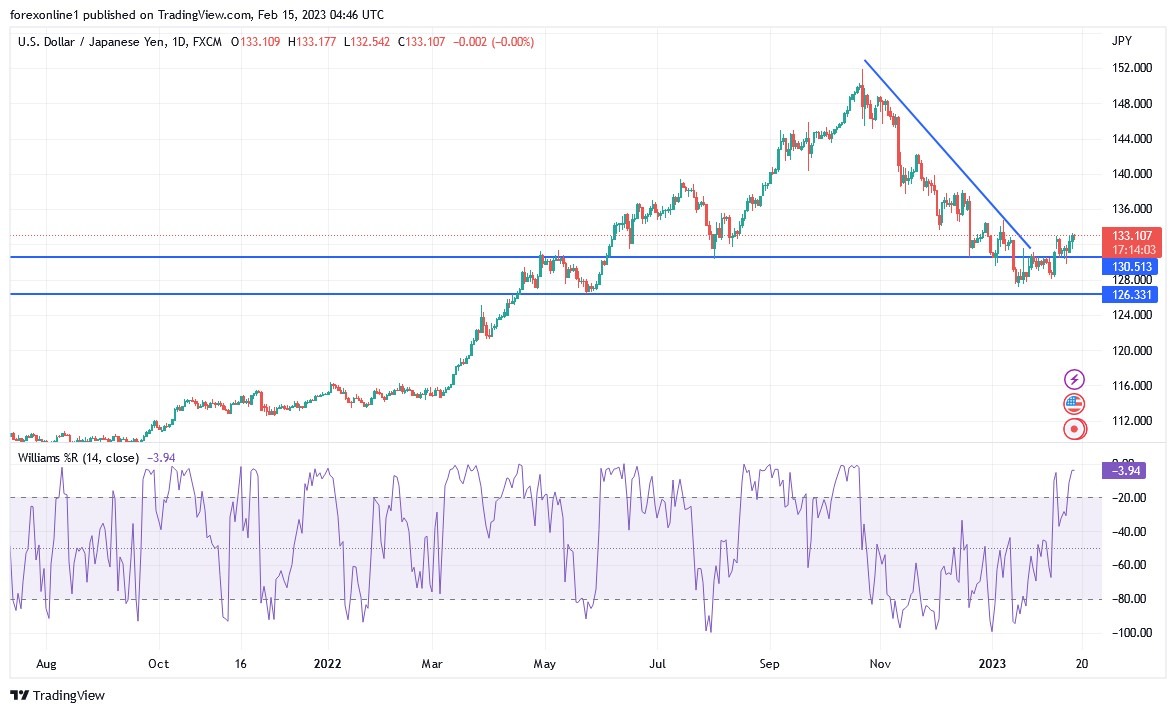The Japanese Yen reacted positively to new data that may indicate that the world's third largest economy may avoid a recession for the time being.
Will that be enough to reverse the downward trend in safe-haven assets?
The Japanese yen was not very happy with its gains, as it was announced who will lead the Japanese central bank. The picture became clear to everyone about the features of the Japanese central bank’s policy, Accordingly, the USD/JPY currency pair returned in its bullish path and tested the resistance level 133.30 at the time of writing the analysis.
According to the latest government data, Japan's GDP growth rate increased by 0.2% in the fourth quarter, up from the 0.3% decline in the third quarter. This was lower than economists' forecasts of 0.5%. Since this was a preliminary estimate, the next GDP update may be revised downward, indicating a technical recession.
Annual GDP growth in the October-December period was 0.6%, up from -1% in the previous quarter. This was also below the market estimate of 2%. Meanwhile, the GDP report revealed other results, such as a decline in capital expenditure growth by 0.5%, an increase in private consumption by 0.5%, and an improvement in external demand to 0.3%. In addition, the annualized GDP price index rose 1.1% in the fourth quarter from -0.4% in the July-September period. Investors will then pay for the Industrial Production and Capacity Utilization data for December. Both are expected to contract by the end of 2022.
For his part, commenting on the data, Daren Tai, Japanese economist at Capital Economics, said: “With other advanced economies approaching recession, we still expect net trade to drag Japan into recession as well in the first half, especially since business investment is weakening faster than we expected.” The other major trend in Tokyo is rising inflation. In December, the annualized consumer price index (CPI) jumped to 4%, and core inflation rose 4% year-on-year. Therefore, Japanese policy makers are dealing with a stagflationary environment: high inflation and low economic growth.
In terms of the US dollar, Federal Reserve officials said that US interest rates may need to move to a higher level than expected to ensure that inflation continues to decline, after new data showed that prices rose at a rapid pace last month. For his part, Richmond Federal Reserve Chairman Thomas Barkin said in an interview with Bloomberg TV on Tuesday that "if inflation continues at levels well above our target, we may have to do more." “We should remain prepared to continue rate increases for longer than previously anticipated, if such a path is necessary to respond to changes in the economic outlook or to offset any undesirable easing of conditions,” said Lori Logan, president of the Dallas Federal Reserve.
Both hung on shortly after data showed consumer prices rose 6.4 percent in January from a year earlier, still well above the Fed's 2 percent annual inflation target, which is based on a separate measure. The overall consumer price index rose 0.5 percent from December, supported by gasoline and shelter costs. This was in line with economists' expectations but represented the largest increase in three months.
"Inflation is returning to normal, but it's slowly coming down," Parkin told Bloomberg's Jonathan Ferro and Michael Mackey. And while Parkin and Logan both participate in Fed Policy Committee meetings, Logan has a vote this year and Parkin does not. US Federal Reserve officials were aggressively raising interest rates to try to calm inflation, which hit a 40-year high last year. Officials in December set a peak interest rate of about 5.1 percent this year, based on median projections.
Forecasts of the dollar against the Japanese yen:
- The bullish trend of the US dollar against the Japanese yen, USD/JPY, is gaining strength.
- Stability is above the resistance at 133.00, it is moving some technical indicators towards overbought levels.
- With the continuation of the US dollar's momentum due to interest rate hike expectations and a strong US economic path, the rebound may continue to the upside. Especially as things become clear to the markets and investors about the future of the Bank of Japan's policy under new leadership.
- Currently, the closest resistance levels for the currency pair are 133.55 and 134.20, respectively.
On the other hand, and for the same time period, the USD/JPY pair will not return to the neutral zone without moving towards the support level 131.00. Today, the US retail sales figures will be announced.
Ready to trade our daily Forex forecast? Here’s a list of some of the best Forex brokers to check out.


